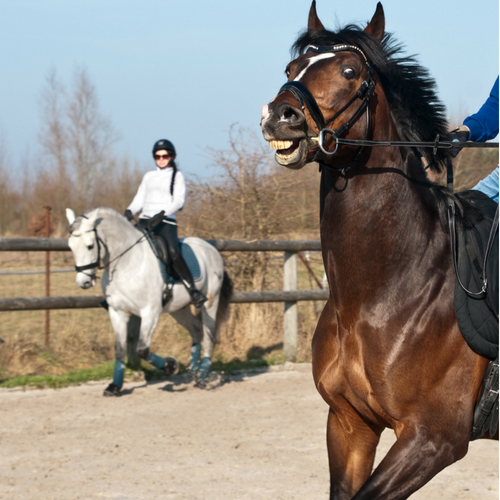What the toss? 8 Reasons Why Your Horse May Be Head Tossing
Head tossing can be difficult to ride and scary for newer riders.
We all see beautiful images of horses working in a self-carriage frame, and then come across a horse that tosses his head or needs to hold it high. It can be frightening, frustrating and unbalancing when we ride these horses.
Understanding why this might be happening can improve our chances of correcting this unwanted behaviour.
Dental and bit issues
Mouth pain created by an incorrectly worn bit or dental issues can lead to head tossing, particularly when you put the bridle on or apply a reign aid – strong or soft. The best way to see if this is the cause of your horse’s head tossing is to have a discussion and examination with your dentist.
Development Issues
A horse that is working hollow is generally going to carry his or her head higher (unless being forced into a frame, which will be uncomfortable and limit the development of your horse). A horse that has poor strength and elasticity through their top-line will also need to use their shoulders and neck to lift, which will bring their head high. Ensure to work through the training scale to maximise your horse’s capability for self-carriage is the only way to fix this, and it will take time.
Anxiety
Horses that are anxious are naturally inclined to have their heads held high on the lookout for danger. Some horses may have anxiety related to one particular issue, and others may be living in a chronic state of anxiety. The best way to deal with an anxious horse is to help them get past the ‘fight or flight’ stage of the anxiety to where they can begin to mentally process their decisions, while at the same time encouraging them to follow you as their calm leader – if you are not anxious, they shouldn’t be either. This may require professional assistance.
Need support training an anxious horse? Training Trainability has your answers!
Click here to view the programTraining Issues
A horse that doesn’t understand or becomes frustrated may toss his head to communicate his confusion. They will usually attempt to do what you ask but become repeatedly confused as we continue to not give the release they were expecting. You may have to work with your trainer to ensure the aids you are applying have been developed from the very basic to the more advanced (as they learn).
Conversely, a horse that knows the training but is trying to avoid putting his head down will react opposite of your aid and lift his head. This may be because the head in frame is too hard to maintain too long, or because he is testing us. Use the pressure/release method to encourage and reward the correct behaviour, and gradually increase the number of strides he has to maintain this.
Saddle Fit
Sometimes, an incorrectly fitting saddle that pinches or rubs may create a number of ‘naughty’ habits, including head tossing. A poorly fitted saddle would be like wearing a bra that is 3 sizes too small in one cup and 2 sizes too big in the other. These naughty behaviours are your horse’s way of telling you they are uncomfortable.
Poll Pressure
Some horses, particularly as they develop, or if they have dental issues, may have a sensitive poll. This is usually due to a tightening of the neck and/or the jaw muscles. Ear twitched horses may also be extra sensitive to this area, as ear twitching creates pain and can damage the muscles in and around the ear. Some great stretches to release poll pressure include low carrots stretches and between the knees carrot stretches. It’s also not a bad idea to review this at your horse’s next chiro visit.
Insects
If you are in a particularly high insect area or time, you may notice your horse tossing his head a lot more. Use some insect repellent on a grooming mitt to gently apply to the areas of the face, ears and neck to help reduce this.
Learned Behaviour
Unfortunately, some horses may have figured out that when they toss their head high, they can scare their rider or owner out of doing what they are asking for, and therefore it has become a learned response to get out of something they deem unpleasant. It takes some time, patience and consistency to break this behaviour, and a lot of pressure/release practice. But persevere – I promise that with the right approach it can be overcome!
overcome problem behaviours with our easy to follow method
Click here to view the programLooking for more specific content?
Have a question you are seeking answers to? Send us a message and we will create a blog!


